Quality is the key for the motorhomes produced by this company, which uses solid construction techniques and a sky’s-the-limit approach to interior and exterior appointments.
By Mark Quasius, F333630
August 2022
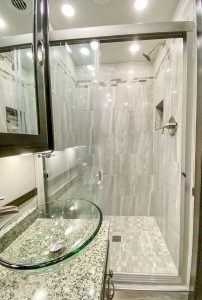
Buyers can create an exterior design and customize the interior, including upscale bathroom features.
ShowHauler Motorhome Conversions builds custom Super C motor coaches in Middlebury, Indiana. Originally, the company provided living quarters for racing and horse-trailering clients. In 2000, an Automobile Racing Club of America (ARCA) driver requested a truck he could live in while at the track that was capable of pulling a large race car trailer. This launched the company’s motorhome conversion business.
The family-owned company constructs custom motorhomes, “toterhomes,” and motorhomes with garages. Other services include remodeling current conversions. The company’s goal is to bring a customer’s vision to life by producing high-quality custom coaches with innovative features. After 20 years and more than 2,000 motorhomes, ShowHauler has become a respected builder of premier custom Super Cs.
I recently toured the company’s production facilities to learn more about the customized approach to Super C design and construction.
Construction
ShowHaulers are designed to last a long time, and that begins with their heavy-duty steel structure. The steel floor subframe provides a stiff foundation on which to build. The large basement cargo bays are crafted with galvanized steel and inserted into a robust steel cage that is welded as part of the frame. Sidewalls incorporate heavy-duty structural steel tubing and are welded to the steel floor framing; no screws are used. Window, door, and slideout openings are framed in 1-inch-by-3-inch steel tubing. The 1-inch-by-1.5-inch steel roof framing is welded to the sidewalls with a heavy steel transition piece; this produces a rigid, welded steel cage that surrounds the coach. In addition to protecting occupants, this eliminates squeaks and noises associated with typical construction methods, where screws may loosen from road flex.
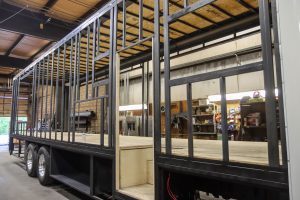
Each ShowHauler motorhome starts with a steel-framed structure.
ShowHaulers are skinned with heavy, .063 aluminum sheathing, which can be replaced easily if damaged. Each panel is lap jointed and sealed with a special 3M tape that allows for thermal expansion and contraction to prevent ripples from forming.
The 1 7/8-inch vacuum-bonded floor is a one-piece structure that includes a corrugated plastic bottom liner and an aluminum frame. One continuous piece of AdvanTech wood is used, which helps eliminate squeaky joints. At 35 feet long and 8 feet wide, this size wood won’t be stocked at your local lumberyard!
The one-piece fiberglass-polypropylene blended roof has a slight curve to promote water runoff and eliminate puddling, and it can be walked on. The roof material is flexible enough to form a 5-inch radius, yet it resists breaking and cracking, even in subzero temperatures. Rather than the more common practice of securing awnings to the roof with screws and wooden block, ShowHauler technicians weld a continuous steel plate to the roof joists; this travels the length of the coach and provides backing for roof-mounted awnings.
ShowHauler also offers innovative slideout designs. Each slideout is framed in aluminum tubing, which minimizes weight and relieves stress from the slideout motors. The electric motors are mounted above the floor, where they can be accessed for service if required. The slideouts themselves are anchored above the floor to help maintain structural integrity. Their side-mounted mechanisms provide support and don’t require rollers beneath them that can leave unsightly marks on the floor. One exception occurs when a long super slideout is installed, which requires an additional roller.
ShowHaulers are true four-season coaches; in fact, a number of units are sold in Alaska. These motorhomes can be ordered with various choices of insulation. The standard insulation used is blue foam board for the walls and reflective waffle foil in the walls and the ceiling. Customers can opt for up to 3 inches of blue board beneath the floor and go with spray foam insulation in the walls and ceiling. In place of lauan, ShowHauler uses 7/16-inch oriented strand board (OSB) sheathing for the interior walls. The reflective foil is applied on the inside of the wall, and either blue board or spray foam is applied from the outside. The spray foam fills every wall cavity, eliminating potential air gaps and places where moisture could pass through.
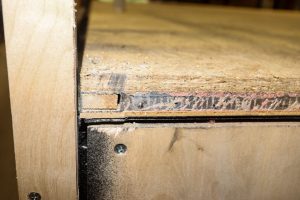
The vacuum-bonded floor includes a corrugated plastic liner, aluminum frame, and continuous piece of engineered wood.
But to enable coach operation in temperatures below freezing, other measures are taken. ShowHauler routes the PEX plumbing above the floor. The fresh-water tank is located beneath the bed in a welded steel cage, along with the water pump. The only fresh-water plumbing below the floor line are the fresh-water connection, extensions to the low-point drains, and connections to the Oasis hydronic heating system.
The Oasis system delivers warmth to the hydronic heat exchangers throughout the coach and in key basement areas. It also provides unlimited domestic hot water and can serve as an engine preheater for cold-weather starts. The system is powered by a diesel burner and a pair of electric heating elements.
Optional tank heaters are available for the gray-water and black-water holding tanks. Standard tank sizes are 150 gallons of fresh water and 75 gallons each of gray and black water, although configurations up to 400 gallons have been built upon customer request. Of course, larger-capacity tanks will take up more basement storage area.
Electrical systems also are customizable. The standard battery bank can be upgraded to a larger bank of flooded, AGM, or lithium-ion batteries. Solar panels and charge controllers can be added, and the typical coach is built with a 12,500-watt Onan Quiet Diesel generator and a Magnum 3,000-watt true sine wave inverter. All underfloor electrical wiring is run in conduit pipe alongside the frame rails to avoid rubbing and chafing.
The exterior invites further personalization. A standard ShowHauler RV is white, but custom paint jobs frequently are requested. The fiberglass rear cap gives the coach a finished look. LED lighting is used, and a choice of Dometic or Girard awnings is offered for mounting to the sidewall or on the roof. Exterior TVs and outside entertainment systems can be selected. Thermal-pane sliding windows or frameless awning-style windows are offered. A heavy-duty steel ladder provides access to the roof. Fiberglass transitions from the coach to the cab help to smooth the airflow.
Chassis
ShowHauler has built motorhomes on Volvo, Kenworth, and Peterbilt chassis, but the most common is the Freightliner Cascadia. This Class 8 truck chassis is designed to ride like a high-end SUV. It comes in lengths of 116 and 126 inches (bumper to back of cab). The Cascadia 116 is suitable for shorter engines, such as the Detroit Diesel DD13, while the Cascadia 126 is required for the larger, 600-horsepower Detroit Diesel DD16.
Most ShowHaulers are built on the Cascadia 126 platform, which is available in various wheelbases, depending on the floor plan length chosen. Longer coaches will have a tandem axle, which allows both axles to drive if extra traction is needed on slippery surfaces. Six-wheel disc brakes are standard, as is air-ride rear suspension.

An Oasis hydronic heating system.
Transmission choices include a six-speed Allison automatic or a 12-speed Detroit DT-12 automated manual transmission. Most are built with the DT-12. The Cascadias are ordered with double 11-inch frame rails and up to a 40,000-pound-rated tow hitch. An 18,000-pound-rated front axle and a 40,000-pound-rated tandem axle set provide a 45-foot coach with a gross vehicle weight rating (GVWR) of 58,000 pounds; so, cargo carrying capacity typically runs well over 10,000 pounds. Equalizer hydraulic leveling jacks are used.
Air-ride seats smooth out bumps and jolts, while the suite of available safety features includes adaptive cruise control, active brake assist, and lane departure alert, among others. LED headlamps, heated mirrors, and Android Auto or Apple Carplay all contribute to an enjoyable drive.
When you drive the ShowHauler, its lengthy front hood gives the sense that you are behind the wheel of a large SUV. Rather than the driver sitting on top of the front axle, as is typical in a bus-style chassis, the front axle is extended and offers more stability. It also adds protection in the event of an accident.
When compared to a Type A motor-home chassis, a Super C’s turning radius is somewhat larger. In addition, the large front hood subtracts about 10 feet of living space. (Type A chassis typically lose about 5 feet, so the cockpit difference may not be as dramatic as it may first seem.)
Interior
“Custom” is also the key word when it comes to interiors. ShowHauler designers can help customers create a floor plan from scratch, or buyers can start with one of the existing floor plans (samples can be viewed on the company’s website). Configurations include shorter single-axle coaches all the way up to 45-foot tandem-axle units. The number of slideouts can change as needed.
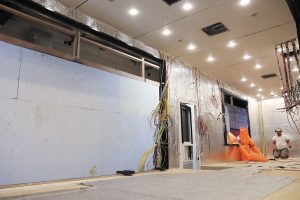
This coach shows a padded ceiling treatment installed along with the lights and air-conditioning ducts.
Most ShowHaulers are built with a spacious cab-over bunk area, which can range from 42 inches to 60 inches in length, offering some great storage room as well as sleeping space for children or adults. If a bunk is not desired, a smaller, aerodynamic fiberglass front cap can be installed. Unlike other manufacturers, ShowHauler supports this cap with additional welded steel framing, which adds strength and protection against impact damage from tree limbs or other hazards.
An available cutout in the bunk facilitates access to the cab area from the coach interior. A bifold panel swings up out of the way and can be folded down to make a bed area when camping. This option is offered only on the Cascadia chassis.
A choice of cabinets, including oak and maple hardwood in five finishes, adds an opportunity to personalize the interior. Ceramic or porcelain tile floors can be heated. Countertops can be Formica, solid surface, granite, or quartz, and the galley backsplash can be whatever tile design customers desire. All cabinets are fabricated in-house by ShowHauler’s head cabinetmaker, who draws upon 18 years of experience. Drawers are dovetailed and installed with soft-close ball-bearing slides. The long list of options also includes residential-quality furniture and appliances.
A Firefly multiplex wiring system incorporates panels at strategic locations throughout the coach to operate lighting, etc. A 10-inch touch-screen central control panel with a color display watches most every feature, which includes the generator, electrical system, tank monitors, and lighting.
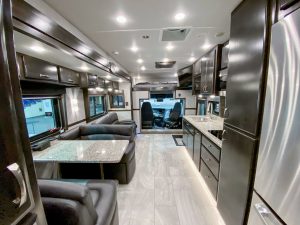
This completed ShowHauler interior shows the front cutaway that provides access to the cab.
As noted, the Oasis hydronic heating system supplies quiet, comfortable heat and domestic hot water. A ducted air-conditioner system delivers the cooling. Most units I saw were built with three 15,000-Btu rooftop air conditioners with heat strips. Ducting carries the air to ceiling registers throughout the coach.
I saw a wide selection of floor plans and interior designs, so it’s fruitless to describe any particular coach in detail. However, ShowHauler does offer a basic unit with a manufacturer’s suggested retail price (MSRP) of around $400,000. As customers add features, the prices go up from there, with the MSRP reaching $650,000 to $700,000.
After my tour of ShowHauler’s production facility, my biggest takeaways were these: The company makes a solidly crafted motorhome that’s “built like a tank.” Instead of selecting an off-the-rack design, clients can customize exterior and interior components. For anyone interested in a tailor-made Super C motorhome, I recommend a visit to ShowHauler to check out their customized approach.
ShowHauler
116 Industrial Parkway E., Middlebury, IN 46540; (574) 825-6764; www.ShowHauler.com

